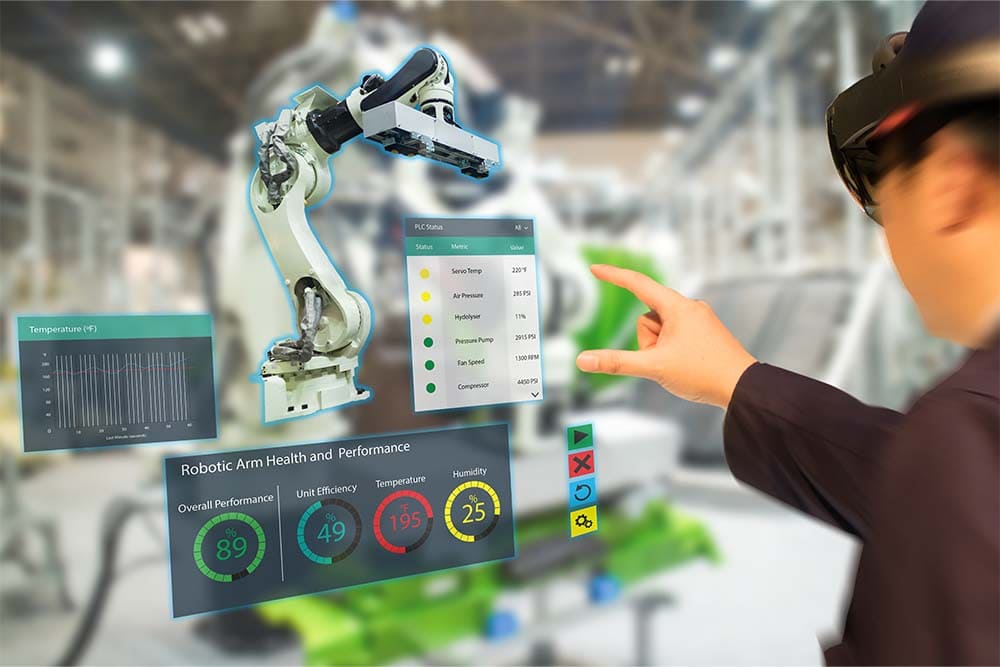The 5 Biggest Virtual, Augmented And Mixed Reality Trends In 2022
18 January 2022
Extended reality (XR) is a catch-all term that covers virtual reality (VR), augmented reality (AR), and mixed reality (MR). In the very simplest terms, VR involves putting on a headset to enter a fully immersive, 3D digital environment, AR involves using a phone or glasses to overlay computer images on top of the real world, and MR can be a combination of both technologies.

Although they achieve it in different ways, they all involve new ways of interacting and experiencing our increasingly digital world. As more and more of our lives – work, socializing, shopping, entertainment – move online, these new ways of interfacing with reality mean we can experience them in ways that are richer and more immersive. In working and professional environments, this means a greater ability to collaborate on projects with colleagues in digital spaces. In entertainment, it means games and activities that feel more “real” than ever before.
This digitization of our lives has accelerated greatly since the start of the pandemic, leading to a growth in interest and innovation around XR and virtual worlds. So here’s a look at some of the key trends that are involved, and how we can expect them to continue shaping our lives throughout 2022 and beyond:
XR and the metaverse
Sometimes called Web 3.0 (or social media 2.0), the metaverse is a concept that’s the focus of a lot of excitement right now - see Facebook’s recent rebrand to Meta. This is likely to remain the case throughout 2022. Although the metaverse doesn’t have to exclusively exist in XR, it’s the version of it that does that’s getting the most attention. This is because more immersive, experiential environments are central to the whole concept – something that XR interfaces lend themselves to very well.
The truth is that no one exactly knows what the metaverse will look like if predictions that it will play a big part in our lives turn out to be correct. But Meta’s focus on the VR aspects (through its hardware brand Oculus) means that it’s likely to be a core feature. 3D environments, avatars, and gamification – three fundamental aspects of the concept – all fit well with VR interfaces. And AR, too, with its potential to blur the distinction between virtual and real worlds, is another idea that meshes well with the metaverse concept. 2022 should see the release of Meta’s Horizon platform, giving people their first taste of what the metaverse could become, and VR will be the window through which they experience it.
More advanced headsets and hardware
Like any technology, the hardware needed to access virtual reality gets smaller and more powerful as time goes on. This is particularly beneficial to the uptake of that technology, when we’re talking about devices that need to be strapped to our heads! As well as lighter VR headsets, AR devices will get lighter, too – California startup Mojo Vision has already demonstrated the potential for AR contact lenses that project information directly onto the retina.
Hardware will offer more features, too. Eye-tracking technology that lets us control interfaces with eyeball movements has already been cracked, thanks to the HHTC Vive Pro Eye headset, and we can expect more software to take advantage of this technology in the coming year. A big advantage here is that the system only needs to render parts of the picture that are being directly viewed in high quality, reducing the power consumption of the headset. Other innovations will attempt to solve the problem of enabling realistic movement within virtual environments (which will always be a problem if your actual environment doesn’t match the size and proportions of your virtual one, and isn’t free of hazards that might cause you to trip over!) Proposed solutions to this problem include both boots, as offered by Ekto VR, and treadmills, like the one developed by Virtuix.
A technology known as haptic feedback will attempt to solve the problem of providing sensations of touch in XR environments. One example is the Teslasuit that provides tactile feedback through electrostimulation. The suit currently costs around $20,000 and, among other uses, is used by NASA for astronaut training, but we can expect to see smaller-scale consumer versions on the market in 2022.
XR in Retail
The retail industry is going through huge changes, both online and offline, and both offer plenty of opportunities to innovate with XR technologies. In online retail, VR solutions can be used to create more engaging and immersive shopping experiences that mimic the "hands-on" advantages of bricks ‘n’ mortar outlets. Meanwhile, in bricks ‘n’ mortar, AR technology can help customers find what they are looking for on the shelves and provide the type of information and feedback opportunities (for example, integrating customer reviews with in-store products) that shoppers have become used to having online.
VR allows online retail experiences far beyond what is possible with typical e-commerce websites – for example, customers can "try on" jewelry and clothing using digital avatars and engage in "personal shopper" interactions with chatbots. In real stores, we can expect more stores to be fitted with AR technologies such as virtual mirrors that allow customers to try on many different items without having to take the time to get changed or even actually touch any products! When they find items they like, they can simply be directed towards where they will be found on the shelves.
XR and 5G
The 5G rollout is gathering pace, and 2022 is looking like it will be the year where uptake becomes widespread enough that it becomes a mainstream proposition. Currently offering speeds around 20 times quicker than existing mobile networks, but with the potential to greatly increase that differential, the benefits aren’t just faster data transmission, but the possibility of different types of data and services. This is likely to include the large data volumes needed to run XR, making wireless and cloud-based VR and AR a possibility. Plutosphere, for example, and other startups offering similar services, let users stream VR games from cloud servers, eliminating the need for users to own expensive gaming PCs packed with powerful graphics hardware in order to enjoy home VR. Gaming has tended to act as the testbed for much of the VR technology that’s currently permeating other industries such as healthcare and education, so we can expect similar solutions aimed at other use cases to emerge during 2022. This will dramatically lower the barriers to entry for many businesses wanting to deploy XR solutions without making large infrastructure investments.
XR in training and education
I believe providing more immersive, engaging, and – in some cases – safer educational opportunities will be one of the biggest growth areas for XR technology in 2022 and beyond. There are a number of reasons for this; firstly, in line with just about every other aspect of our lives, education – particularly adult education and training – is increasingly happening online and remotely. This has been driven by the global pandemic but is clearly a trend that was underway long before lockdowns and school closures became a regular feature of life. Online learning – either in a formal setting such as through a university or training body or informally through one of the ever-growing number of MOOCs – increasingly allows us to fit ongoing learning into our busy lives in ways that would not have been possible 20 years ago.
XR technologies make it easier for students to visualize concepts – from the numbers used in accounting to historical events or even the inner workings of reality exposed through quantum physics – in interesting and engaging ways. Evidence suggests that when we learn through experiencing in this way, rather than simply reading dry facts, we can improve our knowledge retention by 75 to 90%.
VR can also be used to train and simulate operating in dangerous situations, such as the FLAIM system used to train firefighters to tackle wildfire and aircraft fires. And AR is increasingly being used to provide real-time inputs to trainees during on-the-job learning, such as using computer vision-equipped glasses and headsets to recognize and warn of potential dangers in the work environment.
Related Articles
The Third Wave Of AI Is Here: Why Agentic AI Will Transform The Way We Work
The chess pieces of artificial intelligence are being dramatically rearranged. While previous iterations of AI focused on making predictions or generating content, we're now witnessing the emergence of something far more sophisticated: AI agents that can independently perform complex tasks and make decisions.[...]
How Generative AI Will Change Jobs In Cybersecurity
Ensuring robust cybersecurity measures are in place is more important than ever when it comes to protecting organizations and even governments and nations from digital threats.[...]
Sign up to Stay in Touch!
Bernard Marr is a world-renowned futurist, influencer and thought leader in the fields of business and technology, with a passion for using technology for the good of humanity.
He is a best-selling author of over 20 books, writes a regular column for Forbes and advises and coaches many of the world’s best-known organisations.
He has a combined following of 4 million people across his social media channels and newsletters and was ranked by LinkedIn as one of the top 5 business influencers in the world.
Bernard’s latest book is ‘Generative AI in Practice’.






Social Media